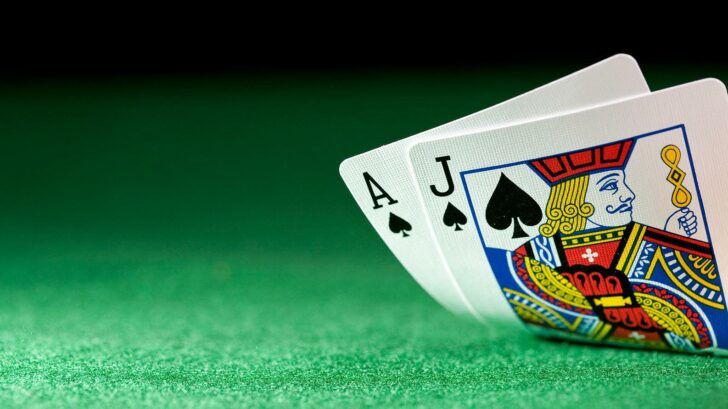The Origins And History Of Blackjack


Blackjack has an interesting history that isn’t one of sudden invention and establishment but of development and evolution over several hundred years.
Sitting at the tables in Vegas eying your blackjack strategy chart whilst simultaneously trying to retain track of the count AND remember which cards were played with that last cluster of aces, it can be all too easy to be swept along with the game. This is both a testament to how enjoyable a good game of blackjack can be, and to how refined the game has become since its loose inception some 300 years ago.
The History of Blackjack Is Over 300 Years Old
• Quinze required players to get 15
• Ventiuna needed players to achieve 21
• Blackjack used to pay out 10/1 in US casinos
Although playing cards themselves appeared during the Tang dynasty in China around the 9th Century it would be nearly 500 years before they reached Europe with the Saracen game of Naib and what we might easily recognize as a 52 card deck. Admittedly at the time the deck consisted of four rather different suits, swords, polo sticks, cups and coins (these days more often found in tarot cards) and featured a king, a governor and a second governor as well as the more usual cards numbered one to ten.
It would be romantic to say that developments in the deck itself were driven by national sensibilities, the desires of noblemen of the time or just by whim of chance or fate, but in actual fact the reason behind the somewhat plain one-to-ten (ace to ten these days) cards we use today was a simple calculation in the cost of production. The suits we know today, a French invention, were an expediency towards single colour printing for MOST of the deck.
The Valet (knave or jack) was introduced along with knight and queen in the 1430s when the Italians had developed a full Latin based Tarot deck which are still used in popular card games today in some countries, although more widely used by the fortune telling fraternity. The fact the French took the concept and made it cheaper being perhaps the sole reason cards broke out and became the popular phenomenon they are today and is an important part of blackjack history.
Ace-Low or Quinze
Despite the relationship between English and French at the time containing absolutely no Entente and precious little Cordiale, the french suited cards became popular this side of the channel in the 16th century and from there spread across the colonies. At the time, of course, it was a knave not jack that sat between ten and queen in the pack, but the Kn abbreviation caused much confusion and the “Jack” term was adopted as time went on.
It was in the 17th century that a game became popular that began to signpost the path towards the game of blackjack that we know and love today, although at first glance the two might not seem all that similar. The origins of the game itself are a tad murky with both French and Spanish influences culminating in one of the simplest, and indeed fairest, card games to grace the gaming tables of Europe.
Quinze was also known at Ace-Low and played between just two players who were both attempting to gain a hand with a value of 15, or close to it, without exceeding that total. They would cut for deal then each be given a card by whomever was dealer, who would then add additional cards upon request from the player. Going over 15 meant a surefire loss, unless the dealer too went over the magic number, in which case it was a draw.
Now unlike modern blackjack the draw would necessitate a doubling of the stakes and a continuation of the game until one or other had won in a legitimate manner. This game was awfully popular at the time since it required little strategy or skill beyond an ability to count to 15, and notable fans of the game included both French king Louis XV, and Casanova (well known womanizer and gambler).
Baraja To Blackjack
The evolution from this game Quinze to the blackjack rules we know today comes via a Spanish game that introduced the total of 21 but used a deck of cards that inexplicably lacked eights, nines and tens. This “baraja” pack and people playing Ventiuna (Spanish for 21) with it around the turn of the 17th century are mentioned by Cervantes not in his famous work Don Quixote but the less work “Rinconete y Cortadillo” in which he describes people in Seville cheating at it.
The short steps between this game and modern day Blackjack are quite easy to track with the use of a different deck (one including those missing eights, nines and tens) being the most obvious. The biggest difference however was the ability to apply the game to a larger number of players than just two, with gambling houses across Europe realizing you could set dealer against any number of players rather than just the two involved in Quinze.
It is, of course, this ability for the forerunners of modern casinos to use it as a house-run game that ensured the spread and popularity of Ventiuna, but where, you might ask, did the name blackjack come from because as yet we’ve heard precious little mention of it. Well the origins of that particular name for the game comes from the USA where casinos originally offered a 10/1 payout on hands featuring the ace of spades and either the jack of clubs or jack of spades.
Of course casinos no longer offer this rather attractive payout but the name for that hand “blackjack” stuck as a name for the game as a whole. There is slightly more smart strategies on offer in this game than the original Quinze, but in essence it was a game that has been enjoyed for more than 300 years by people who have won, lost and played again in casinos and royal courts the world over.




